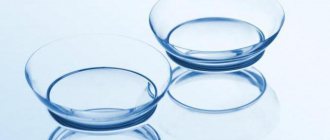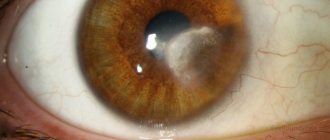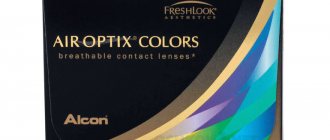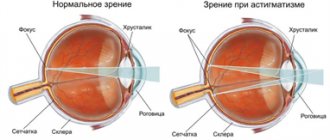Benefits of children's lenses
The appearance of vision problems in children requires a mandatory visit to an ophthalmologist. The doctor must conduct an examination and select the appropriate method of correction. The ophthalmologist must take into account the child's reluctance to wear glasses, and therefore he can select special lenses. The doctor uses a special table to select contact lenses.
Benefits of contact lenses for children:
- The lenses do not interfere with sports and games, which is very convenient, because children are very mobile and active.
- The field of view in lenses, unlike glasses, is not narrowed. The child clearly sees all the objects around him.
- Lenses increase self-esteem and give self-confidence.
- Replacing lenses if they are lost will cost less than buying new glasses.
- The lenses can be worn for nearsightedness, farsightedness and astigmatism.
Read how to put on contact lenses correctly here.
Helpful advice:
For the first time, while the habit of wearing lenses is just forming, you can choose daily replacement lenses for your child. They do not need to be rinsed with solution, so the child will only need to learn how to carefully put on and remove the lenses. In addition, such lenses are more hygienic, because... Every day the child will put on a new pair of lenses.
The development of conjunctivitis or blepharitis, which can occur due to improper cleaning of lenses designed for a longer period of wear, is reduced to zero here. When the child is already accustomed to wearing lenses, it will be possible to choose bi-weekly or monthly replacement lenses.
Correct selection of lenses and compliance with the rules for wearing them is the key to the health of a child’s eyes. If these conditions are met, you can start wearing lenses before you reach 14 years of age. In our company you can purchase lenses from the world's leading manufacturers and everything you need to care for them and receive the necessary consultations from an ophthalmologist.
You can choose contact lenses using the “Beginner” program, which includes an vision test, selection of contact lenses, training in wearing and the first contact lenses as a gift! Sign up for your first contact lenses fitting using this link.
To complete the “Beginner” program, children under 18 years of age must have a recent report from an ophthalmologist. You can be examined by a pediatric ophthalmologist at the addresses indicated here or at the clinic at your place of residence.
At what age can a child wear lenses?
Ophthalmologists believe that age has no effect on the process of using contact lenses. But it should be remembered that very young children will not be able to follow the rules of hygiene, which in this case are very important. Often, children under seven or eight years old have not yet developed a sense of responsibility, so they cannot adhere to strict rules. It is believed that lenses can be prescribed when a child reaches the age of eight to ten years.
It is recommended to use lenses from the age of fourteen. This is the optimal age when a child can responsibly care for contact lenses.
If vision problems were discovered at an earlier age, then doctors do not prohibit wearing lenses. In this case, the parents’ task is to explain to the child the need to care for lenses. They should teach him how to use optics correctly so that there are no complications later.
You can read about caring for long-term wear lenses here.
Studies have been conducted in which it was determined that eight out of ten adolescent children can easily cope with lens care after three months of wearing them.
Many parents are concerned that wearing contact lenses may worsen their child's vision. Indeed, myopia often progresses in school-age children, and over time they will require increasingly stronger contact lenses. But the factor in the development of myopia in this case is not the lenses, but a large visual load. Ophthalmologists believe that lenses do not slow the progression of myopia.
You can learn about long-term soft lenses in this article.
What types of lenses are there and how to choose the right product?
You have already found out whether you can wear colored lenses. Now let's look at what they are:
- Colored. Their main feature is a complete change in the shade of your eyes. Please note that the most natural look can be achieved only if the iris is well drawn.
- Tinted. They differ from colored ones in the intensity of their color. It is 20% less. You won’t be able to completely change the color of your eyes, but making them more expressive and deep is entirely within your control.
— Decorative. The iris in this case has a special pattern or color effect.
- Carnival. They have a festive look and completely change your eyes. You can purchase lenses with the effect of cat or vampire eyes, smiley, dollar.
- Cosmetic. This is a special type of product that is prescribed by a doctor to eliminate or hide certain defects: different eye colors, unequal pupil sizes, complete or partial absence of the iris.
Features of selection
Properly selected contact lenses, both for myopia and farsightedness, should:
- Be comfortable and made from material that is safe for eye health.
- Have a correctly selected radius of curvature, diopter and thickness.
- Have an optimal diameter for the eyes.
According to the wearing mode, lenses are divided into:
- Daily wear lenses. They need to be removed before going to bed, treated with a special solution and stored in a container.
- Extended wear lenses. They can be worn without taking them off for a week or more.
- Lenses with flexible wearing mode. Can be worn for up to two days in a row.
- Constant wear lenses. They can be worn for a whole month.
You can find out more about multifocal contact lenses in the material.
For myopia and farsightedness, spherical lenses are prescribed, and for astigmatism, toric lenses are prescribed.
It should be remembered that if a child has contraindications to wearing lenses, then they should not be used. Factors that prevent you from wearing lenses include :
- Eye inflammation: conjunctivitis, keratitis, scleritis, uevitis, blepharitis and so on. Lenses can cause irritation, poorly transmit oxygen, and therefore can lead to exacerbation of inflammatory diseases.
- Inflammation of the lacrimal sac, obstruction of the lacrimal ducts and insufficient production of tear fluid. First you need to eliminate these problems, and then you can wear lenses.
Read about permanent wear lenses here.
For myopia
Nearsightedness or myopia is a vision problem in which a person has difficulty seeing distant objects.
Only an ophthalmologist can choose the right lenses. Under no circumstances should you experiment and select lenses for your child on your own, otherwise your vision will deteriorate even more. An ophthalmologist conducts an examination during which he determines visual acuity, the condition of the cornea and other structures of the eye. Based on this, the doctor selects the required optical power of contact lenses and their other parameters. In most cases of myopia, soft contact lenses are prescribed.
The longer the lenses are worn, the more careful care they require. The best option for children is daily contact lenses.
Stages of selecting lenses for myopia:
- A trip to the ophthalmologist's office , where a full examination is carried out, but on the basis of which the doctor will give his recommendations.
- Purchasing lenses. When buying lenses, you should give preference to well-known manufacturing companies whose products have already proven themselves in the market as high quality. In general, it is best to consult an ophthalmologist on this issue if you are purchasing lenses for the first time.
- The choice of lenses depending on the period of wear. The shorter the period, the better, since with prolonged wear, germs and deposits accumulate in greater quantities.
- Cost of lenses. You should not chase profit and buy cheap lenses that can harm the health of your child’s eyes.
- Lens material. Silicone hydrogel is recognized as the best material. It allows oxygen to pass through well and ensures eye hydration throughout the entire period of wearing.
For farsightedness
Farsightedness or hypermetropia is a visual impairment characterized by the fact that a person has difficulty seeing objects located at a close distance from him. Correctly selected contact lenses for the correction of farsightedness should help your child see clearly both near and far.
If the lenses are chosen incorrectly, the child will feel discomfort, irritation, and fatigue.
Just as when selecting lenses for myopia, an ophthalmologist should select lenses to correct farsightedness. Farsightedness can be corrected with spherical lenses. And if a child sees poorly both near and far, then he will be prescribed multifocal contact lenses, which have several zones that are responsible for correcting near and far vision.
Is it possible to treat cataracts with folk remedies without surgery?
Find out what eye drops your doctor may prescribe for glaucoma in this article.
How to check a child’s vision using tables: https://eyesdocs.ru/proverka-zreniya/tablicy/tablica-dlya-proverki-zreniya-u-detej.html
At what age can you wear colored lenses?
Children's eyes are exposed to enormous stress every day:
reading books, endless homework, modern devices, television. As a result, some children's vision begins to deteriorate. Spectacle correction can contribute to the development of self-doubt, because it is in childhood that self-esteem is formed. Colored lenses will cope with the task with a bang.
Optical products will correct a child’s vision and preserve a vulnerable psyche. Modern technologies make it possible to create ultra-thin “breathable” models that are absolutely safe for daily use.
Contact lenses for children
A rhetorical question
At what age can you wear colored lenses? Ophthalmologists are confident that the optimal age to start wearing optical products is 8-10 years. Much depends on the degree of responsibility of your baby. Is he ready to perform certain manipulations every day?
Don't be so quick to be disappointed. According to statistics, children are more responsible than adults in such matters.
However, remember that colored lenses for children
- This is, first of all, a medical product. This means that they should be selected by an ophthalmologist after an examination. It will use a hardware method to determine individual parameters: base curvature, diopters, lens diameter. Armed with these characteristics, you will be able to find the perfect pair.
Time for truth
To avoid throwing money away, tell your child a few simple rules before purchasing contact optics.
- You need to take care of your lenses regularly. Rinse daily, change the solution in the storage container, take care of the wearing time. Are you sure you're ready for this?
- If you feel discomfort, do not try to solve the problem yourself, but turn to an adult.
- Do not “over-wear” contact correction products for longer than the specified period. For example, wear for 2 weeks after opening the blister for 6-8 hours a day.
- Be examined by an ophthalmologist twice a year.
If the child agreed with all the requirements, then there is no point in denying him an extraordinary way of self-expression. At what age can children wear contact lenses? From the moment when your child is able to independently take responsibility for his decisions.
Recommendations for selection
Selection of lenses for children
In the Marquise
you will find cutting-edge models from the best manufacturers from around the world. We are the official representative of French, Italian, Korean, Turkish and Brazilian brands. The catalog contains products from brands such as Solotica, Marquise, ADORE, Desio, Rainbow, Urban, HERA and Hypnose.
You should start from the natural shade of your child’s iris. Our online store offers 3 types of models:
- tint;
- colored;
- carnival.
The first ones will make the natural shade of the iris rich and effective without radically changing the color. The latter have a dense structure and can easily replace blue eyes with brown, green with gray, etc. Masquerade models are not intended for daily use. They are used at festivals and creative competitions.
Colored brown lenses have many tones: chestnut, golden, amber, etc. For example, the RainBow brand has released a new amber product in a honey shade - thin premium optical products at an attractive price have proven themselves well among our regular customers.
Check out the GL Retro ocre walnut pair with piping. They are guaranteed to cover the natural color of the iris and at the same time look as harmonious as possible.
If your choice is blue colored lenses, take a closer look at Marquise royal blue or GL Retro blue. Consult with your child what shade of lenses he would like to have: sky blue, cornflower blue, aquamarine, blue-gray, turquoise. This creative process is sure to leave wonderful memories of the time spent together.
Gray colored lenses are a very versatile option and not at all boring. Just take a look at pearl or ice from the Rainbow brand. What do you think of the model with dark gris trim from the same brand? They look stylish and expressive. Children are recommended to buy copies with a service life of up to 3 months. This way you will protect your child from infections and inflammations.
Green colored lenses are ideal for red-haired babies with freckles. They will add enthusiasm and ease. Take a closer look at our customer favorites: Marquise white green, Rainbow verde and Urban Layer Cloud green. The versatility of the green shade is difficult to convey in words: bottle green, malachite, emerald, in a word, for every taste.
Precautionary measures
Can children wear colored lenses? Of course, yes, if they are ready to unquestioningly follow the following rules.
- Wash your hands thoroughly before any manipulation of optical products.
- Always remove correction products before going to bed: carefully remove, place in a clean storage container and fill with a disinfectant solution.
- Do not wear contact lenses for more than 6-8 hours a day.
- If discomfort occurs, remove the lenses, inform your parents about the problem, and consult a doctor.
- Once every 7-10 days you need to clean it using a special product or an ultrasonic device. This will likely require adult assistance.
It is impossible to give an exact answer to the question “at what age can you wear colored lenses?”
This is decided on an individual basis. This takes into account not only the degree of physiological development, but also the moral and cultural qualities of the child. Colored lenses themselves are not harmful if you care for them properly.
Online store for colored lenses:
colorlens24.ru
Source: https://zen.yandex.ru/media/id/5e94417ba254c70136352855/s-kakogo-vozrasta-mojno-nosit-cvetnye-linzy-5e971efdd680b22c3e2b70b7
conclusions
Don't know how to choose the right lenses for your eyes? An ophthalmologist will help you with this. When properly cared for and worn, contact lenses are absolutely safe for children. A child's eyes can quickly adapt to lenses, so lenses can even be prescribed to infants in some cases. If the child is ready and knows how to care for the lenses, and most importantly, that he wants to wear them, then the parents can allow him to do this. Parents should remember that they must supervise and teach their child how to use contact lenses correctly. If problems arise, even if they seem minor at first glance, they and the child should consult an ophthalmologist. With the correct selection of lenses for correcting farsightedness and myopia and proper care, a child can use them safely. And don’t forget about the existence of drops for lens wearers.
How to care for your lenses?
In order for these products to serve effectively and for a long time, you need to take care of them. Perform the following manipulations daily: at night, it is advisable to place the lenses in special containers filled with cleaning disinfectant liquid.
The solution should be changed daily. If its expiration date has expired, it is better to throw the product away. It is advisable to change the lens container every 3 months. The fact is that some substances contained in the liquid can accumulate on its walls.
Now you know how and for how long you can wear colored lenses. Good luck!










